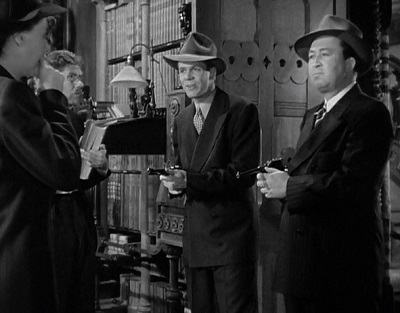Having A Ball
I recently watched Howard Hawks' Ball Of Fire (1941*). I don't know how many times I've seen it, but it's always a delight. Hawks was a master of comedy in the screwball age, and BOF stands up with the best of his work. Yet, for decades, many critics have given this film the back of the hand. Why?
For those who haven't seen it, the plot involves Barbara Stanwyck as Sugarpuss O'Shea, girlfriend of mob boss Joe Lilac (Dana Andrews). He's under investigation, and to avoid the DA, she hides out at a Manhattan townhouse where eight professors live. They've been busy for years compiling an encyclopedia. She was invited by Gary Cooper's character, the shy Professor Bertram Potts, to help him in his study of current slang.
Potts falls in love with O'Shea, and unwittingly brings her to Lilac, where the plan is she'll marry the gangster so she won't have to testify. But at some point, she falls in love with Potts, and, after Potts deals with Lilac, they end up together.
The screenplay is by one of the top writing teams in Hollywood at the time (or any time), Charles Brackett and Billy Wilder. This was around the time they wrote other comedy classics, such as Midnight and the first Hollywood film Wilder directed, The Major And The Minor. And I think this is why the critics have some trouble with Ball Of Fire. It isn't a pure Hawks, it's a hybrid.
Hawks' earlier classic comedies--Twentieth Century, Bringing Up Baby, His Girl Friday--are a lot faster than Ball Of Fire. Their dialogue and stories moves like few other films. Ball Of Fire is willing to take its time. It's an hour and fifty-one minutes in an era when most comedies weren't much longer than ninety.
Also, Hawksian comedy--not unlike his drama--is no-nonsense. It's not particularly sentimental. In fact, it can be fairly heartless. His romantic comedies feature couples who do nothing but fight for the entire movie until the last moment when they realize they love each other. Wilder, for all his cynicism, is much warmer, and his scripts are clear in their romantic development: start with two opposites and have them slowly realize how much they mean to each other.
(Also, Hawks' comedies don't feature that many wisecracks, preferring the laughter arise from character and situation. Brackett and Wilder love wisecracks. For instance, when Sugarpuss is trying to convince the professors she's sick, she shows them her throat and says "it's as red as the Daily Worker and just as sore.")
Brackett and Wilder know how to pull off a romantic comedy. The trouble with Ball Of Fire is it's just not Hawks. So critics who are fans of Hawks see a comedy that takes its time and is full of sentiment and are put off. But why let that get in the way? Forget who's behind it, and just enjoy the film.
*1941 was an amazing year for Stanwyck, Cooper and Hawks. Not only did they make Ball Of Fire, which is enough for any year, but Stanwyck appeared in another classic, The Lady Eve, and also co-starred with Cooper in Capra's Meet John Doe. In addition, Cooper appeared in another film, directed by Hawks--the biggest hit of the year, in fact--Sergeant York, for which he won an Oscar.




0 Comments:
Post a Comment
<< Home